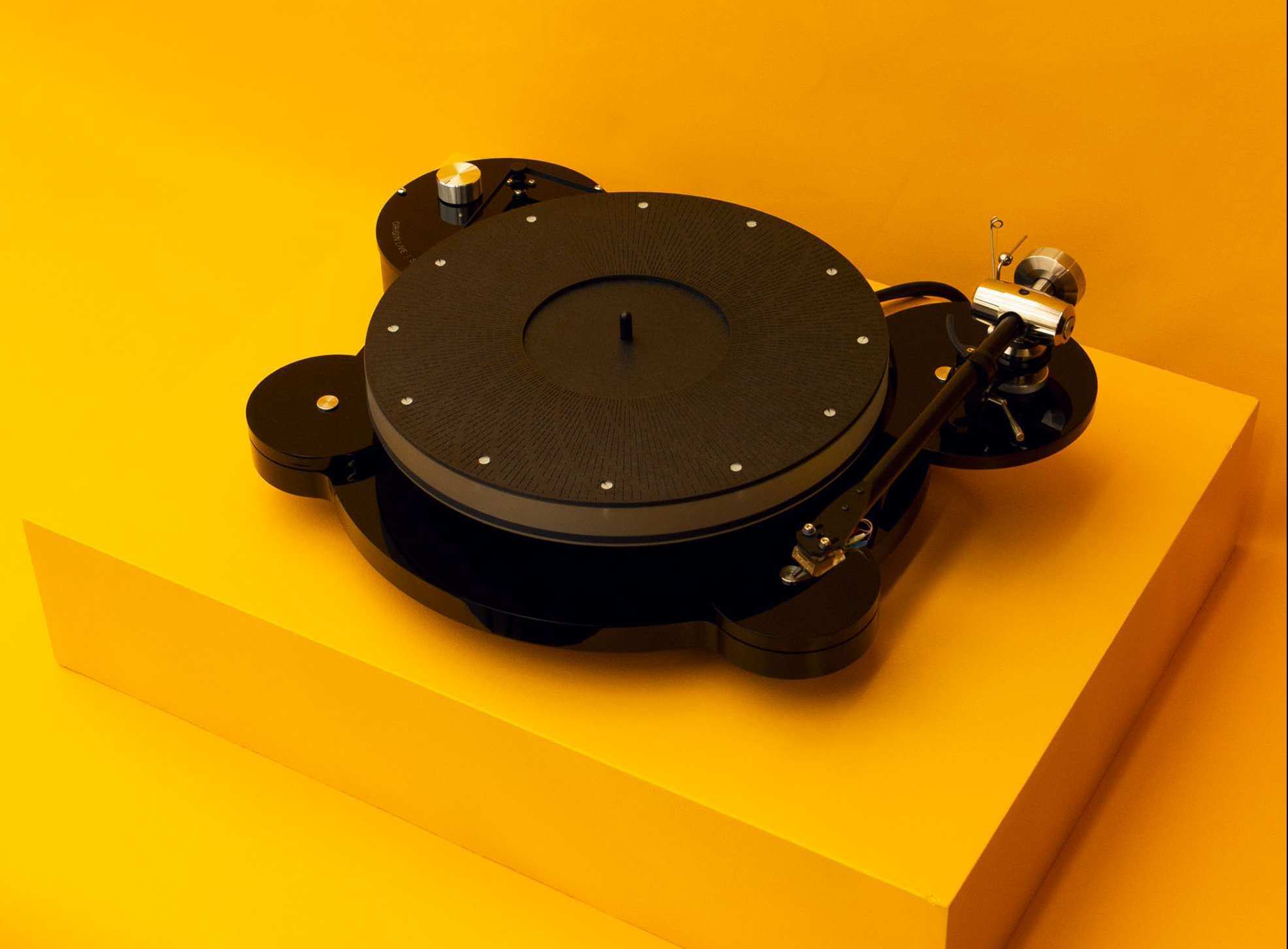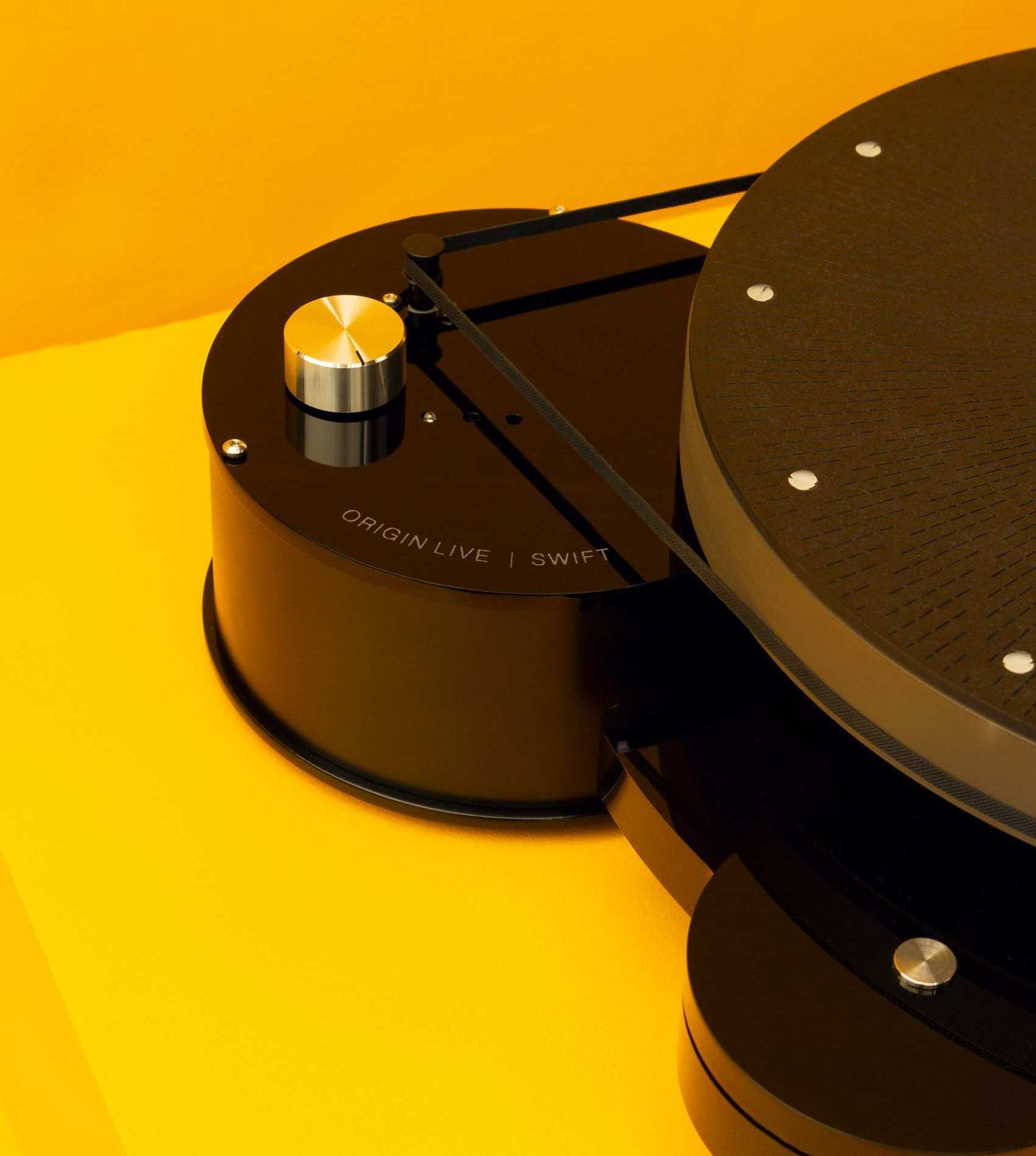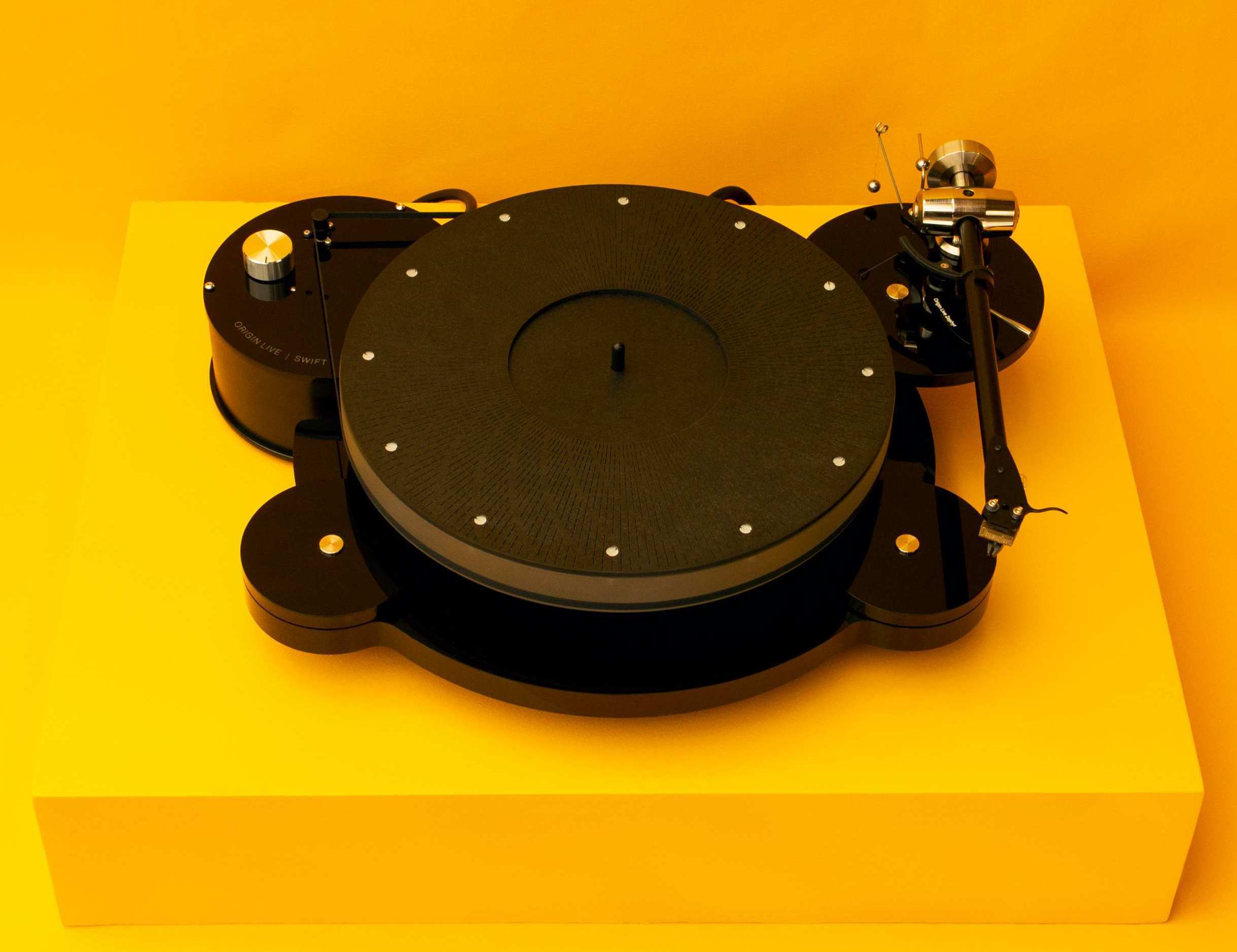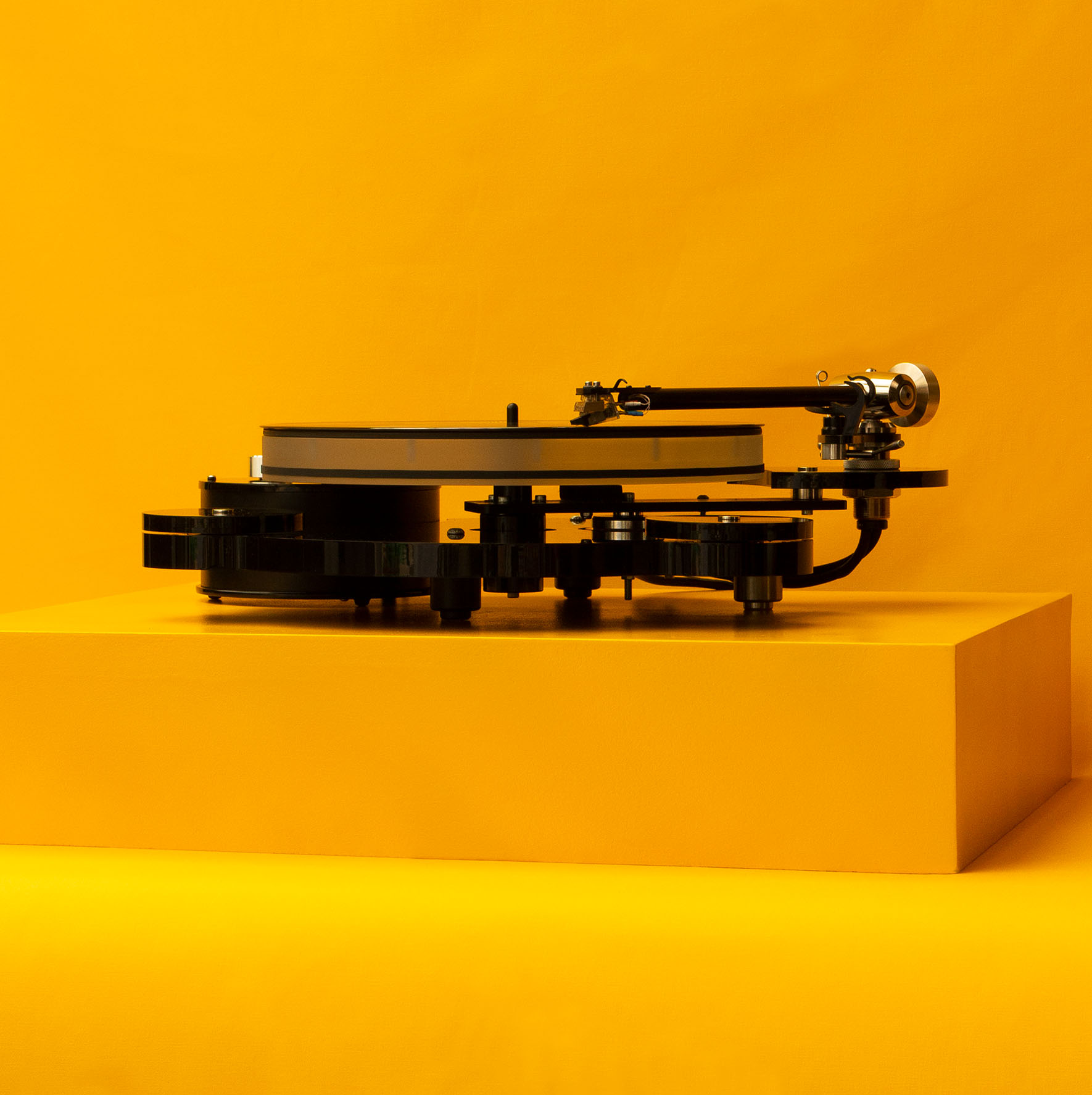Swift Turntable
The Swift adds the Multi-Layer Platter to the basic design of the Aurora turntable, with its cantilevered design, motor power supply and decoupled arm board. The MLP layers work to diffuse surface resonance in the platter through vibrational interference, resulting in a texture in the music freed from resonant artefacts. This new turntable delivers a performance that surpasses its price point by miles, offering a sure investment for your system.

Swift Turntable
The Swift adds the Multi-Layer Platter to the basic design of the Aurora turntable, with its cantilevered design, motor power supply and decoupled arm board. The MLP layers work to diffuse surface resonance in the platter through vibrational interference, resulting in a texture in the music freed from resonant artefacts. This new turntable delivers a performance that surpasses its price point by miles, offering a sure investment for your system.


Features
Mk5 Motor Power Supply
The Mk5 Motor Power Supply introduces a new PCB in the PSU on all decks offering even more speed stability and improved sonic performance than the former Light Speed Controller. Common problems like speed drift, motor jitter and cogging are avoided. Speed settings for 33.33 and 45 RPM are operated through one knob with no need for belt/platter change.
DC100 Motor
These high-grade Swiss motors demonstrate the powerful, smooth-running needed in a good turntable motor. Ironless cores eliminate eddy currents which result in low “clogging”, low vibration and speed stability. Motors are decoupled to minimize vibration and reduce audible noise.
Belt
The belt is manufactured in house using special material which increases grip and reduces stretch under instantaneous loading, using a unique material which dramatically improves on widely used neoprene rubber – benefits include increased dynamics and deeper bass performance.
Features
Mk5 Motor Power Supply
The Mk5 Motor Power Supply introduces a new PCB in the PSU on all decks offering even more speed stability and improved sonic performance than the former Light Speed Controller. Common problems like speed drift, motor jitter and cogging are avoided. Speed settings for 33.33 and 45 RPM are operated through one knob with no need for belt/platter change.
DC100 Motor
These high-grade Swiss motors demonstrate the powerful, smooth-running needed in a good turntable motor. Ironless cores eliminate eddy currents which result in low “clogging”, low vibration and speed stability. Motors are decoupled to minimize vibration and reduce audible noise.
Belt
The belt is manufactured in house using special material which increases grip and reduces stretch under instantaneous loading, using a unique material which dramatically improves on widely used neoprene rubber – benefits include increased dynamics and deeper bass performance.

Multi Layer Platter
The Multi Layer Platter (MLP) is trickle down tech from our flagship Voyager turntable, featuring an intricately designed top with over 1000 individual slots laser cut through the top layer. Combined with another composite layer underneath and carefully screwed on to the acrylic platter. The MLP layers work to diffuse surface resonance in the platter through vibrational interference, resulting in a texture in the music which is freed up from resonant artefacts.
High Specification Power Supply
Carefully selected cables from premium suppliers are attached to motor circuitry that is designed to ensure the motor, the platter and your vinyl are running smoothly on a consistent power supply.
Standard Armboard
Our standard armboard provides premium performance for the price point. Decoupled from the rest of the turntable, the armboard is balanced in equilibrium with the platter and bearing house.
Pulley
A well researched special plastic pulley enables maximum belt grip, resulting in increased definition and dynamics over.

FEATURES CONTINUED
Multi Layer Platter
The Multi Layer Platter (MLP) is trickle down tech from our flagship Voyager turntable, featuring an intricately designed top with over 1000 individual slots laser cut through the top layer. Combined with another composite layer underneath and carefully screwed on to the acrylic platter. The MLP layers work to diffuse surface resonance in the platter through vibrational interference, resulting in a texture in the music which is freed up from resonant artefacts.
High Specification Power Supply
Carefully selected cables from premium suppliers are attached to motor circuitry that is designed to ensure the motor, the platter and your vinyl are running smoothly on a consistent power supply.
Pulley
A well researched special plastic pulley enables maximum belt grip, resulting in increased definition and dynamics over.
Standard Armboard
Our standard armboard provides premium performance for the price point. Decoupled from the rest of the turntable, the armboard is balanced in equilibrium with the platter and bearing house.


Ultra-low Friction Bearing
Made in house, the new MK4 bearing has ultra low levels of vibration. The spindle rotates on a Tungsten carbide ball bearing centered on a hardened thrust pad for low friction and long life. Low bearing friction is essential to avoid vibration. Unlike decks which “float” the platter using air or magnetic bearings, we believe “earthing” the energy out of the platter is essential for sound purity.
High Specification Sub-Chassis
The sub-chassis plate balances the armboard with the platter and bearing house, decoupling both from the turntable plinth. Its mass heavy design also helps to effectively damp vibration travelling through the armboard and platter.
Suspension
Our unique suspension avoids both the softening of leading edges often found in suspended designs and the hardness in many non-suspended designs. The results are:
- Superior pitch, rhythm, and timing
- Rock-solid imaging
- Reduced colouration
- Refined presentation of low-level information
- Easy to follow separation in the music and vocals
FEATURES CONTINUED
Suspension
Our unique suspension avoids both the softening of leading edges often found in suspended designs and the hardness in many non-suspended designs. The results are:
- Superior pitch, rhythm, and timing
- Rock-solid imaging
- Reduced colouration
- Refined presentation of low-level information
- Easy to follow separation in the music and vocals
High Specification Sub-Chassis
The sub-chassis plate balances the armboard with the platter and bearing house, decoupling both from the turntable plinth. Its mass heavy design also helps to effectively damp vibration travelling through the armboard and platter.
Ultra-low Friction Bearing
Made in house, the new MK4 bearing has ultra low levels of vibration. The spindle rotates on a Tungsten carbide ball bearing centered on a hardened thrust pad for low friction and long life. Low bearing friction is essential to avoid vibration. Unlike decks which “float” the platter using air or magnetic bearings, we believe “earthing” the energy out of the platter is essential for sound purity.

Compare Turntable Features
| TURNTABLE | Aurora | Calypso | Resolution | Sovereign | Voyager |
| Multi-layer Platter |
No | No | No | Yes | Yes |
| High Performance Armboard | No | No | Yes | Yes | Yes |
| Motor |
DC100 | DC100 | DC100 | DC100 | DC100 x 2 |
| Sub-Chassis Inertia Disc | No | Yes | Yes | No | No |
| Heavyweight Plinth |
No | No | No | Yes | Yes |
| Maximum Decouping on Main Bearing |
No | No | Yes | Yes | Yes |
| “Footprint” of deck & Minimum Dimensions of Support Surface (cm) (WxD) | 40 x 29 | 40 x 29 | 40 x 29 | 40 x 29 | 40 x 37 |
| Overall Size with 9.5 inch arm see top line (cm) (Width x Depth x Height) For 12 inch arms use lower line |
49x36x17 55x36x17 |
49x36x17 55x36x17 |
49x36x17 55x36x17 |
50x38x19 55x39x19 |
– |
| Weight (kg) | 10.3 | 11.5 | 12.1 | 28.4 | – |
| Shipping Dimensions (cm) (Width x Depth x Height) |
60 x 45 x 16 | 60 x 45 x 16 | 60 x 45 x 16 | 60 x 50 x 30 | B1.:48 x 48 x 33
B2: 60 x 73 x 30 |
| Weight Packaged (kg) (Width x Depth x Height) |
12 | 13.3 | 13.9 | 32 | B1: 9.05 B2: 26.3 |
Options and Extras
12 Inch Armboard
In general, we think that 12″ arms almost always outperform their 9.5″ counterparts. The method commonly employed by other brands, for fitting 12-inch arms is to change the armboard. However, our arm boards are integrated into the structure of the sub-chassis. To accommodate for 12″ arms, we have an option to change the Sub-chassis of the turntable. Only 12-inch Origin Live tonearms will normally fit this option – other 12-inch arm brands can be quoted on a case-by-case basis.
To find out more about our 12″ armboard: Read more>
To learn about the advantages of 12-inch arms over 9″ arms, read our helpful article here.
Dual Arm-Board
The dual armboard allows two 9.5″ Origin Live or Rega’s arms to be fitted to the deck. You might want a dual armboard if you:
• If some of your records are dirty or damaged you can play them through a cheap cartridge without needing to change it.
• You may have 2 cartridges for particular applications such as a mono cartridge for mono records.
• If you set up the arms for different record thicknesses it avoids needing to keep adjusting the VTA
• Dealers use them to enable quick comparisons of different tonearms with the same cartridge
If you are considering this option, then it is easier and saves money to order the dual armboard sub-chassis with the deck and not at a later date.
Dust Cover
We do not make or sell dust covers ourselves, but we can make a few recommendations. You can order a bespoke Lid from various online plastic stores, This is a good idea if you have young children or pets and need a completely enclosed solution. If however you just need to keep dust off the platter and arm then the Michell Unicover will usually suffice.
All options and extras can be added to your order at checkout.
Choosing Turntables
High Performance Turntables Produce the Ultimate Sound Quality
The record player still reigns supreme in terms of performance. Experts agree that leading turntables provide a more satisfying musical experience than any digital counterparts. Unlike digital streaming & CD, there seems no limitation on the musical information that turntables can extract from vinyl. In recent years, advances in some turntables have caused the gulf between digital performance and vinyl to widen even further. Origin Live draws together many long-established principles of high-end turntable design, along with advanced innovations, to reveal just how much the vinyl medium is capable of.
Why invest in a quality turntable?
If you are unfamiliar with Hi-Fi you may be unaware of the major sound quality differences between one turntable and another. There are over 800 different decks on the market. Faced with such a colossal choice, many buyers take the shortcut and assume “if it looks good, and has a good review, it must be good”. Unfortunately, nothing could be further from the truth. To its credit, the Hi-Fi press has long extolled the importance of a good turntable for high sound quality. If the source signal is degraded in the first place, everything else in the Hi-Fi Chain can only exaggerate the problem. It is important to choose your turntable based on its sound quality, which comes from its engineering and design.
Here at Origin Live, we make almost all of our components in our own workshop in the UK, this means we are in total control of the materials, quality control, and design of our products. You won’t find any chipboard, plywood, or flimsy components in these turntables. Using mass effective design in our bearing houses, plinths, arm boards and platters, all possible areas where jitter and vibration can be removed have been carefully considered. Through relentless development, we have selected materials that produce the natural, uninhibited tone from your vinyl.
Turntable Differences Are Greater Than Any Other Item Of Hi-Fi Equipment
CD players sound different to one another, but not a lot in comparison to turntables. Turntables have more influence on the sound of a system than almost any other item of Hi-Fi equipment and the differences between them are massive. A better turntable will improve the clarity, dynamics and ability to follow every strand of the music plus other aspects too numerous to mention. Gone is blurred, woolly bass and general confusion in the sound. Better turntables also have increased pitch stability adding a sense of sub-conscious sense of rhythm, security and confidence to your listening experience.
Rewards Of Higher Investment
A cheap £165 turntables will fall well short of CD performance, whereas a good £1500 turntable should outperform CD. The pursuit of the ultimate sound goes well beyond CD quality however. Turntables can improve a lot further with the right choices in equipment, and often this involves higher investment.
No one could blame you for being sceptical that a truly high-performance turntable is worth the investment. It’s usually only by hearing a direct comparison between two similar-looking decks, that the penny drops. The difference in musical cohesion, dynamics and ability to follow music effortlessly is simply jaw-dropping. It leaves one wondering how such massive differences can possibly exist when outward appearances can look so similar. Usually, this is down to materials, design and engineering. We explain further in our article: what makes the best turntable.
The conclusion is that it’s worth hearing turntable differences so you know what’s possible in terms of sound quality.
Warranty
All of our turntables come with a 5-year warranty against manufacturing defects. Accidental damage is not covered under this warranty. Tonearms are not included in the 5-year warranty.
Deciding On Your Priorities
Acquiring a good Record Player is a process that’s really worth getting right. Like buying a house, it’s going to be with you for a long time. There are many mediocre decks on the market with excellent reviews. This makes finding the best turntable all the more difficult. If you pay attention to every review that ends with words to the effect of ” worth adding to your shortlist”, you will end up with hundreds of turntables to audition.
It pays to evaluate your priorities in making your choice and the following provides a checklist of things to consider:
- Aesthetics – You probably want to like the look of your deck but it also needs to fit in with your decor or other Hi-Fi Components
- Sound Quality (should be very important for long term enjoyment and the differences are huge)
- Reliability – Some designs have far greater longevity than others due to better design. It’s difficult without naming specific manufacturers to identify the problems that arise and this is an aspect on which reviewers are unable to comment
- Upgradability – Some decks are much more difficult to upgrade and exchange than others. This is a complex subject but thinks in terms of changing arms or part exchange.
- Build Quality – Most manufacturers have little to differentiate between them in this aspect
- Size of the turntable – Will it fit the space available
- Set up – how easy is it to set up the deck?
- Servicing, maintenance and repair – Typically decks with suspension using springs and rubber grommets need regular servicing as the rubber compresses
- The speed may also need to be checked and adjusted due to belt wear. Service costs vary massively between turntables
- Popularity – A “safety in numbers” approach is sometimes valid but too many notable exceptions make this an unreliable benchmark
- Resale value – Linked to the above is re-sale value. Less well-known decks or those without spectacular endorsements and awards do not do so well on the 2nd hand market
- There is general advice on selecting products and apportioning your budget in How To Choose Hi-Fi